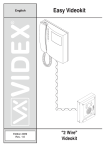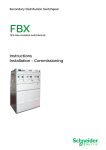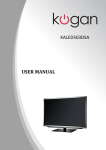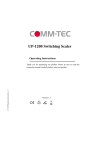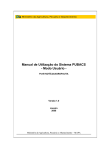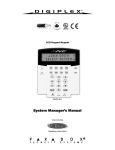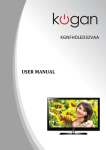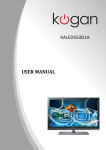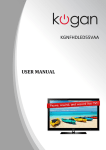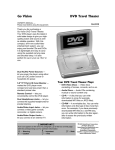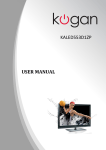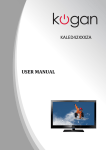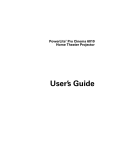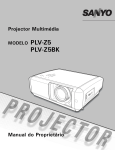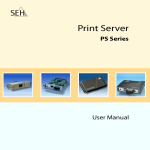Download LCD - SuperMax
Transcript
KL32QS62+KL42QS62 A5 A5 A5 A5 3 90 39 02 4 Please read this manual carefully before TV operation. Retain it for future reference. Important Safety Instructions and Maintenance Important Safety Instructions CAUTION Risk of electronic shock, do not open. Do not attempt to service this product yourself as opening or removing covers may expose you to dangerous voltage or other hazards. Refer all servicing to qualified service personnel. High Voltage Do not open If the following problems occur: Turn off the TV set and unplug the AC power cord immediately if any of the following problems occur. Ask your dealer or service centre to have it checked by qualified service personnel When: - AC power cord is damaged. - Poor fitting of AC power outlet. - TV set is damaged by being dropped, hit or having something thrown at it. - Any liquid or solid object falls through openings in the cabinet. To reduce the risk of fire or electric shock, do not expose this product to rain or moisture. The apparatus shall not be exposed to dripping or splashing and no objects filled with liquids, such as vases, shall be placed on the apparatus. The screen and cabinet get warm when the TV is in use. This is not a malfunction.In case of smoke, strange noise or strange smell from the unit: Turn off the power switch immediately; Disconnect the power plug from the power outlet; Contact your dealer or service centre. Never attempt to make repairs yourself because this could be dangerous. Never push objects of any kind into the set through the cabinet slots as they may touch dangerous voltage points or short-circuit parts that could result in a fire or electric shock. Never spill liquid of any kind on the set. Use special caution in households where children are present. The apparatus is not suitable for children under 3-year to operate. Do not overload wall outlets, extension cords or adaptors beyond their capacity, this can result in fire or electrical shock. Power-supply cords should be routed so that they are not likely to be walked on or pinched by items placed upon or against them, paying particular attention to cords at plug end, adaptors and the point where they exit from the appliance. The mains plug is used as the disconnect device. It shall remain readily accessible and should not be obstructed during intended use. Make sure to plug the power cord in until it is firmly inserted. When removing the power cord, make sure to hold the power plug when pulling the plug from the outlet, do not pull the plug out by the wire. NEVER touch the plug or power cord with wet hands. To disconnect the apparatus from the mains power, the plug must be pulled out from the mains socket, therefore make sure the mains plug is always easily accessible. 1 Important Safety Instructions and Maintenance Important Safety Instructions Do not push or scratch the front filter, or place any objects on top of the TV set. The image may be uneven or the screen may be damaged. To avoid the fire, no naked flame source, such as lighted candles, should be placed on the apparatus. An outside antenna system should not be located in the vicinity of overhead power lines or other electric light or power circuits, or where it can fall into such power lines or circuits. When installing an outside antenna system, extreme care should be taken to keep from touching such power lines or circuits as contact with them might be fatal.Ensuring the television is not overhanging the edge of the supporting furniture. When not in use If you will not be using the TV set for several days, the TV set should be disconnected from the AC mains for environmental and safety reasons. As the TV set is not disconnected from the AC power when the TV is turned off at the standby switch, pull the plug from the AC power outlet to disconnect the TV completely. However, some TV sets may have features that require the TV set to be left in standby to function correctly. In the case of lightning, unplug the TV set from the outlet immediately. Never touch the antenna wire during lightning. Do not pull the plug out by the wire; Never touch the plug with wet hands. Excessive volume from earphones and headphones can cause hearing loss. Installation The ventilation should not be impeded by covering the ventilation opening with items, such as newspapers, tablecloths, curtains, etc. At least 10 cm space should be left around the apparatus for sufficient ventilation. The product should be situated away from heat sources such as radiators, heat registers, stoves, or other products (including amplifiers) that produce heat. Place the apparatus in such a position that the screen is not exposed to direct sunlight. It is best to have soft indirect lighting while watching and avoid completely dark environments and reflection from the screen as these may cause eye fatigue. Keep the TV set away from any equipment emitting electromagnetic radiation. 2 Important Safety Instructions and Maintenance Installation Do not place the set on an unstable cart, stand, table or shelf. The set may fall, causing serious personal injury as well as damage to the product. Use only with the cart, stand, tripod, bracket, or table specified by the manufacturer, or sold with the apparatus. An appliance and cart combination should be moved with care. Quick stops, excessive force, and uneven surfaces may cause the appliance and cart combination to overturn. Do not place this apparatus near water, for example, near a bath tub, wash bowl, kitchen sink, or laundry tub; in a wet basement; or a swimming pool; and the like; Mo v e When the TV being moved in from cold place, it needs some right time for dew inside unit evaporating fully before turn on the unit; To prevent injury, this apparatus must be securely attached to the floor/wall in accordance with the installation instructions. LCD Screen Although the LCD screen is made with high precision technology and 99.99% or more of the pixels are effective, black dots may appear or bright points of light (red, blue or green) may appear constantly on the LCD screen. This is a structural property of the LCD screen and is not a malfunction. If the surface of the LCD panel cracks, do not touch it until you have unplugged the AC power cord. Otherwise electric shock may result. Do not throw anything at the TV set. The LCD panel may break from the impact and cause serious injury. Precautions When Displaying a Still Image A still image may cause permanent damage to the TV screen. Do not display still images and partially still images on the LCD panel for more than 2 hours as it can cause screen image retention. This image retention is also known as "screen burn". To avoid such image retention, reduce the degree of brightness and contrast of the screen when displaying a still image. Watching the LCD TV in 4:3 format for a long period of time may leave traces of borders displayed on the left, right and centre of the screen caused by the difference of light emission on the screen. Playing a DVD or a game console may cause a similar effect to the screen. Damages caused by the above effect are not covered by the Warranty. Displaying still images from Video games and PC for longer than a certain period of time may produce partial after-images. To prevent this effect, reduce the 'brightness' and 'contrast' when displaying still images. Cleaning Cleaning and handling the screen surface and cabinet. Disconnect the unit from the AC outlet before cleaning. To remove dust, wipe gently with a soft, lint free cloth. If required use a slightly damp cloth. solvent thinner MAINS PLUG Wipe the mains plug with a dry cloth at regular intervals. Moisture and dust may lead to fire or electrical shock. Use care not to subject the TV's surfaces to detergent. (A liquid inside the TV could lead to product failure, fire or electrical shock.) Use care not to subject surfaces to bug repellent, solvent, thinner, or other volatile substances as this may deteriorate the surface and finish of the cabinet. 3 Important Information Keep small accessories out of reach of children so they are not mistakenly swallowed. Table of Contents Introduction Accessories----------------------------------------------------------------------------------------------- 5 Features--------------------------------------------------------------------------------------------------- 6 Specifications-------------------------------------------------------------------------------------------- 7 Stand and wall-mounting instructions (optional)----------------------------------------------- 8 Overview of back panel------------------------------------------------------------------------------- 10 Overview of front panel------------------------------------------------------------------------------- 11 Overview of remote control-------------------------------------------------------------------------- 12 Teletext --------------------------------------------------------------------------------------------------- 14 Installing Batteries in the Remote Control-------------------------------------------------------- 16 External Connection-------------------------------------------------------------------------------------- 16 Antenna connection------------------------------------------------------------------------------------ 16 Connecting VCR --------------------------------------------------------------------------------------- 17 Connecting a Camcorder----------------------------------------------------------------------------- 18 Connecting a DVD Player/Set-Top Box ---------------------------------------------------------- 19 Connecting a DVD Player/Set-Top Box via DVI ---------------------------------------------- 20 Connecting DVD Player/Set-Top Box via HDMI ---------------------------------------------- 21 Connecting PC ----------------------------------------------------------------------------------------- 22 Supporting signals ---------------------------------------------------------------------------------------- 22 Basic operation Turning the TV on and off---------------------------------------------------------------------------- 23 Menu operation ---------------------------------------------------------------------------------------- 24 Menu system instruction-------------------------------------------------------------------------------- 25 Picture---------------------------------------------------------------------------------------------------- 25 Sound----------------------------------------------------------------------------------------------------- 26 Function-------------------------------------------------------------------------------------------------- 27 Option-------------------------------------------------------------------------------------------------------28 Channel----------------------------------------------------------------------------------------------------30 Digital Media Player ------------------------------------------------------------------------------------- 32 Reference Troubleshooting ------------------------------------------------------------------------------------------- 42 Picture defects and the reason----------------------------------------------------------------------- 44 4 Introduction Accessories Please make sure the following items are included with your LCD TV. If any items are missing, contact your dealer. OK YPb Pr Owner s Instructions Remote Control CAUTION: Batteryx2 Do not dispose of batteries in a fire. Do not short circuit, disassemble or overheat the batteries. Danger of explosion if battery is incorrectly replaced, please observe polarity. Replace only with the same or equivalent type. 5 Introduction Features l TV adopts 3 2"42" TFT LCD display screen l Zero X radiation complies to green environment protection requirement l l l l l l l Connect to computer directly to realize TV/monitor combo. 16:9 wide screen Auto tuning and fine tuning HDMI input Component Compatible (480i; 480P; 576i; 576P; 720P; 1080i; 1080P) PC VGA Programmable sleep timer l Wide range voltage input l No-signal automatic power off Input terminals used for external equipment connection 1 x ANTENNA jack 3 x HDMI inputs 1 x computer VGA/PC input 2 x USB inputs 1 x AV output 1 x COMPONENT input 2 x AV inputs 1 x Headphone output 6 Introduction Specifications Model SM3262USK SM4262USK Display size 32 42 LCD panel resolution 1366X768 1920X1080 Speaker output power 5 W X2 5 W X2 Diagonal (max.) Diagonal (max.) Power supply ~110-240V, 50/60Hz TV receive system Analog: PAL: BG, DK, I, Frequency range Analog: Antenna: Video in PA L / NTS C / SECAM PA L / NTS C / SE C AM Power consumption 120W 180W Standby consumption <0 .5W <0.5W Antenna Input 75 ohms, unbalanced 75 ohms, unbalanced Controller power DC 3V (Two AAA size batteries) DC 3V (Two AAA size batteries) 777X230X568 1008X251.5X682.1mm 777X112X517 1008X116X639.5mm 8.9Kg 20Kg 8.4Kg 17Kg Work Temperature o ~110-240V, 50/60Hz SECAM: BG, D/K 46.25MHz-855.25MHz o Analog: PAL: BG, DK, I, Analog: Antenna: o 0 C-4 0 C SECAM: BG, D/K 46.25MHz-855.25MHz o 0 C-40 C Note: - Design and specifications are subject to change without notice. - Weight and Dimension shown are approximate. - Due to TV may be used with different display screen, weight or panel resolution marked in this user s manual or on packaging box is subject to change without notice. 7 Stand and wall-mounting instructions (optional) How to assemble the stand? The LCD TV is assembled without the stand before leaving the factory, if you need to assemble the stand, operate as follows: -Before attaching/detaching the stand, make sure to turn off the TV. -Before performing work, spread cushioning over the base area to lay the LCD TV on. This will prevent it from being damaged. 1. Assembling instruction(Only for 32 model): 1) Fix the post on the stand with the five screws (size:M4*16). 2) Put the Television on the table(rear upwrd), fix the stand on the Television with the 6 screws given in the carton.(Figure 2) 2. Assembling instruction(Only for 42 model): 1) Fix the stand and the transition board together with screws. (Please refer to figure 1) 2) Attach the stand to the LCD TV. (Hold the stand so it will not drop from the edge of the base area.) (Please refer to figure 2) 3) Fasten the screws used to secure the stand in place. (Please refer to figure 3) - To detach the stand, perform the above steps in reverse order. 4 -M 5X8 Figure 2 Screws f or t he st and 8 Figure 3 Stand and wall-mounting instructions (optional) Wall mounting instructions (optional) Your TV is able to accommodate wall mounting with the use of a wall mount bracket (not supplied with TV, please contact your local hardware store) and the mounting holes on the back of the unit. We recommend removing the TV stand prior to wall mounting the TV. Please see previous page for instructions on removing the stand. Caution: Pulling, pushing, or climbing on the TV may cause the TV to fall. In particular, ensure your children do not hang over or destabilize the TV; doing so may cause the TV to tip over, causing serious injuries or death. Follow all safety precautions at the start of this manual. How to mount the TV on the wall 1.After detaching the stand, fasten 4 mounting screws (thread size M6X10 - not supplied! Please contact your local hardware store) into the 4 screw holes on the rear cover, see the figure below. 2.Fasten wall mounting bracket (Not supplied with TV, please contact your local hardware store) with screws on the wall. 3.Carefully check for the strength before releasing the TV. NOTE: For more detailed instructions please refer to your after market wall mounting instruction book. 200 mm (For 32 model) 600mm 400mm (For 42 model) Thread hole size M6 x 10 depth (TV mounting screw size) on the TV. 9 General Description Overview of back panel You can connect the TV with video devices such as DVD/VCD player, VCR and video camera to enjoy the high quality picture. USB USB1 Headphone USB2 VIDEO VID EO AUDIO AU DIO AV1 IN AV1 IN For 32 model For 42 model AV2 IN V GA /PC IN R L Y VIDEO2 PB PR R L VID E O SPDIF OU T PC AUDIO IN AV OUT HDMI 1/2/3 Connect to the HDMI jack of a device with an HDMI output. Use the HDMI terminal for DVI connection to an external device with a DVI output. You should use a DVI to HDMI cable or adaptor for video connection, and the PC AUDIO IN terminal for audio. - No sound connection is needed for an HDMI to HDMI connection. Sound connection is only needed for DVI to HDMI. VGA/PC IN Connect to the video output jack on your PC. PC AUDIO IN Audio input for external devices. COMPONENT (YPBPR) Connect Component video/audio. AV OUTPUT Connect to the video and audio output jacks on your amplifier/home theater. SPDIF Connect to a Digital Audio devices. USB Headphone Audio socket for connecting a pair of headphone. AV1 IN AV input for external device. RF IN Connect to an antenna or cable TV system. Note: The product and illustrations in this user's manual is only for explanation purposes and may vary depending on model. 10 General Description Overview of front panel The buttons on the lower-right panel control your TV s basic features, including the on-screen menu. To use the more advanced features, you must use the remote control. P R OG P R OG MENU Press to display an on-screen menu of your TV's features. PROGr/s Press to change programs. In the on-screen menu, use the PROGr /sbuttons as up/down arrow buttons. VOLr /s Press to increase or decrease the volume. In the on-screen menu, use the VOL r /s buttons as left/right arrow buttons. Standby button Press button to toggle between normal and standby mode. Power Switch Press this button to turn TV on or off. REMOTE CONTROL SENSOR Aim the remote control towards this spot on the TV. POWER INDICATOR Green: In power on mode. Red: In standby mode. INPUT Toggles between all the available input sources . 11 General Description Overview of Remote Control OK YPbPr 1. INPUT: This button is used to switch among different sources: TV, AV1, AV2, YPbPr, VGA, HDMI1, HDMI2, HDMI3, USB1,USB2. Select a source and press OK button to confirm. 2. POWER: Press this button to switch to standby mode, and press it again to turn TV on. 3. Digital buttons(0~9): To select channel with digital buttons. 4. INFO: This button is used to start the "Current Service Banner" application that provides information about the current service. 5. RECALL: Switch to the previous program. 6. FREEZE : Press this button to freeze the image. 7. MENU: Press this button to display main menu or exit the menu. When you are in the submenu, you can press it to return the main menu. 8. SLEEP: TV will be switched off automatically at preset sleep time if you have set sleep timer. Use your remote control to set the sleep timer. Press SLEEP button on the remote control, then press this button again to set sleep time: off, 10, 20,30, 60,90,120,180, 240 min. Press MENU button to exit when you have set the sleep timer. After you have set sleep timer, press SLEEP button again, you will see the Remaining time. Notes: The sleep timer you have set will be Cancelled when the TV turns off or if a power failure occurs. 9. CH.LIST: Press it to show channel list on screen. 10. FAV: Press it to display favorite list. 11. Arrow buttons: Press these buttons to move cursor up/down/left/right for menu. 12. OK: Press this button to confirm. 13. ASPECT: Press this button to switch the screen mode. 14. Exit: Exit the menu. 15. TV: Switch to TV mode directly. 16. HDMI: Switch to HDMI1 mode directly, press twice to switch to HDMI2, press three times to switch to HDMI3. 12 General Description Overview of Remote Control 17. USB: Switch to USB mode directly or call the control menu in USB mode. Please see the details in Digital Media Player on Page 32-41. 18. YPbPr: Switch to YPbPr mode directly. 19. VOLr and VOLs: Press these buttons to adjust TV volume. 20. PROGrand PROGs: Press these buttons to change channel upward or downward. In the teletext, these buttons are used to display the next page and previous page. 21. MUTE: Press this button to shut off sound of the TV, press again to restore TV sound. OK 22. Button/Audio Lang: In TV source, the button is used to set NICAM sound system. 23. Red/Green/Yellow/Blue Command: These four YPbPr buttons are used to request linked buttons with the current menu/page. 24. Teletext buttons: Detail operation please refer to "Teletext in the next page. 25. SOUND: This button is used to select the sound mode. Standard " News " Movie " Sports " Dance # $ Sof t ! Jazz ! R ock ! Pop ! C lassic 26. PICTURE: This button is used to adjust user picture mode, press this button repeatedly and select one of four settings. Standard " Mild " User " Dynamic 27. MIX : Teletext buttons for mix function, please refer to page 15. 13 General Description Teletext Teletext is an information system broadcast by certain channels which be consulted like a newspaper. It also offers to subtitles for viewers with hearing problems or who are not familiar with the transmission language. You can press these buttons to operate the teletext: Text Press TEXT button to enter or exit teletext mode. Hold Press HOLD button to toggle Hold function on or off. When Hold is switched on, the page acquisition is stopped. When Hold is switched off, the page OK acquisition is started. Size Press SIZE button one time to display the upper YPbPr half of the screen in double height, press the SIZE button two times to display the lower half of the screen in double height, press three times to display the full screen in normal size. Red/Green/Yellow/Blue Command These four buttons are used for quick access to 13 different pages as numbered at the bottom of the screen. Index Press INDEX button, then index page displays. Reveal Pressing this button will reveal any hidden data (answers to quizzes for example).Press the REVEAL button again to return to normal screen. 14 General Description Teletext OK YPbPr 13 13 Cancel The CANCEL button will exit from any Teletext on the display. Press CANCEL button again to exit Teletext and return to live TV broadcast. Subtitle Turning the Teletext subtitles on or off. Subtitles is a separate mode with only a few buttons available. There will be no OSD visible other than the Teletext Subtitles. Subcode Subcode mode gives the possibility to select certain subcode pages of a Teletext page. Entry of digits within the range 0...9 for current subcode entry. If the digit completes the entry, a page request is started. Time This button is used to show the time of the Teletext. Digital buttons(0~9) You can press them to enter the number of the Page required. PROG+/PROGYou can press them to change page upward or downward. Mix Press MIX botton, the teletext page changes transparent, TV content and teletext page content will display at the same time. Press MIX button again to exit MIX mode. 15 General Description Installing Batteries in the Remote Control 1 Open the battery compartment cover on the back s ide. 2 Insert two 1.5V AAA size batteries in c orrect polar ity. Don t mix old or used batteries with new ones. P oin t th e rem ote towards the remo te control sensor of the TV a nd use it wi thin 8 meters. P ut the used batteries i nto the recycling bin since they can n egatively affe ct the environment. 3 Closed the cover. The batteries (battery pack or batt eries installed) shall not be exposed to excessive heat such as sunshine, f ire or the like. External Connection Antenna connection Antenna input impedance of this unit is 75ohm. VHF/UHF 75ohm coaxial cable can be connected to the antenna jack directly, if the antenna cable is 300ohm parallel flat feeder cable, you need to use the 300ohm/75ohm converter to connect the antenna cable to the antenna jack. For details Please refer to the following drawing. Antennas with 300 Ω flat twins Leads Antennas with 75 Ω Round Leads Use a 75ohm - 300ohm converter ANT IN 75ohm coaxial cable 300ohm coaxial cable Antenna cable Antenna feeder 16 External Connection Connecting VCR These instructions assume that you have already connected your TV to an antenna or a cable TV system. Skip step 1 if you have not yet connected to an antenna or a cable system. VCR Rear Panel ANT ANT OUT S-VIDEO VIDEO OUT AUDIO OUT Side panel 5 Audio Cable (Not supplied) 4 Video Cable (Not supplied) 3 RF Cable (Not supplied) VID EO AU DIO V GA/P C I N AV 2 I N R R L Y VI DEO2 PB PR L VI DEO SP DIF OU T PC AUD IO IN AV OU T AV1 IN Follow the instructions in Viewing a VCR or Camcorder Tape to view your VCR tape. Each VCR has a different back panel configuration. When connecting a VCR, match the color of the connection terminal to the cable. 1. Unplug the cable or antenna from the back of the TV. 2. Connect the cable or antenna to the ANT IN terminal on the back of the VCR. 3. Connect an RF Cable between the ANT OUT terminal on the VCR and the ANT IN terminal on the TV. 4. Connect a Video Cable between the VIDEO OUT jack on the VCR and the VIDEO IN jack on the TV. 5. Connect Audio Cables between the AUDIO OUT jacks on the VCR and the AUDIO L and AUDIO R jacks on the TV. If you have a mono (non-stereo) VCR, use a Y-connector (not supplied) to hook up to the right and left audio input jacks of the TV. If your VCR is stereo, you must connect two cables. Note: 1. Whenever you connect an external device to your TV, make sure that power on the unit is turned off. 2. When connecting an external device, match the color of the connection terminal to the cable. 17 External Connection Connecting a Camcorder The side panel jacks on your TV make it easy to connect a camcorder to your TV. They allow you to view the camcorder tapes without using a VCR. Side panel 1 Video Cable (Not supplied) Camcorder White 2 Audio Cable (Not supplied) Red VID EO AU DIO AV1 IN Each Camcorder has a different side panel configuration. When connecting a Camcorder, match the color of the connection terminal to the cable. 1. Connect a Video Cable between the VIDEO jack on the TV and the VIDEO OUT jack on the camcorder. 2. Connect Audio Cables between the AUDIO L and AUDIO R jacks on the TV and the AUDIO OUT jacks on the camcorder. Note: 1. Whenever you connect an external device to your TV, make sure that power on the unit is turned off. 2. When connecting an external device, match the color of the connection terminal to the cable. 18 External Connection Connecting a DVD Player/Set-Top Box The rear panel jacks on your TV make it easy to connect a DVD to your TV. DVD Player/Set-Top Box TV Rear Panel Component Cable (Not supplied) Audio Cable (Not supplied) AV2 IN V GA /PC IN R L Y VIDEO2 PB PR R L VI D E O SPDIF OU T PC AUDIO IN AV OUT Component video separates the video into Y (Luminance (brightness)), Pb (Blue) and Pr (Red) for enhanced video quality. Be sure to match the component video and audio connections. For example, if connecting the video cable to COMPONENT IN, connect the audio cable to COMPONENT IN also. Each DVD player/STB has a different back panel configuration. When connecting a DVD player/STB, match the color of the connection terminal to the cable. 1. Connect a Component Cable between the COMPONENT IN [Y, PB, PR] jacks on the TV and the COMPONENT [Y, PB, PR] jacks on the DVD player. 2. Connect Audio Cables between the COMPONENT IN [R- AUDIO-L] jacks on the TV and the AUDIO OUT jacks on the DVD player. Note: 1.Whenever you connect an external device to your TV, make sure that power on the unit is turned off. 2.When connecting an external device, match the color of the connection terminal to the cable. 19 External Connection Connecting a DVD Player/Set-Top Box via DVI This connection can only be made if there is a DVI Output connector on the external device. TV Rear Panel DVD Player/ Set-Top Box VGA/PC IN AV2 IN R R L Y V ID EO2 PB PR L VIDEO SP DI F OUT PC AU D IO IN AV O UT White Red 2 Audio Cable (Not supplied) 1 DVI to HDMI Cable (Not supplied) Each DVD player/STB has a different back panel configuration. When connecting a DVD player/STB, match the color of the connection terminal to the cable. 1. Connect a DVI to HDMI Cable or DVI-HDMI Adapter between the HDMI 1, HDMI 2, HDMI 3 connector on the TV and the DVI connector on the DVD player/Set-Top Box. 2. Connect Audio Cables between the PC AUDIO IN jack on the TV and the AUDIO OUT jacks on the DVD player/Set-Top Box. Note: 1.Whenever you connect an external device to your TV, make sure that power on the unit is turned off. 2.When connecting an external device, match the color of the connection terminal to the cable. 20 External Connection Connecting DVD Player/Set-Top Box via HDMI This connection can only be made if there is a HDMI Output connector on the external device. DVD Player/ Set-Top Box VGA/P C IN AV2 IN R R L Y VI DEO2 PB PR L VIDEO SP DI F O UT PC AUD IO IN A V OUT TV Rear Panel HDMI Cable (Not suppli ed) What is HDMI? HDMI, or high-definition multimedia interface, is a next-generation interface that enables the transmission of digital audio and video signals using a single cable without compression. Multimedia interface is a more accurate name for it especially because it allows multiple channels of digital audio (5.1 channels). The difference between HDMI and DVI is that the HDMI device is smaller in size, has the HDCP(High Bandwidth Digital Copy Protection) coding feature installed, and supports multi-channel digital audio. Each DVD player/STB has a different back panel configuration. 1. Connect an HDMI Cable between the HDMI1, HDMI2, HDMI3 connector on the TV and the HDMI connector on the DVD player/Set-Top Box. Note: 1.Whenever you connect an external device to your TV, make sure that power on the unit is turned off. 2.When connecting an external device, match the color of the connection terminal to the cable. 21 External Connection Connecting PC VGA/PC IN A V2 IN R R L Y V ID EO2 PB PR L VIDEO SP DI F OUT PC AU D IO IN AV OUT PC 2 PC Audio Cable (Not supplied) 1 D-Sub Cable (Not supplied) Each PC has a different back panel configuration. The HDMI jacks do not support PC connection. 1. Connect a D-Sub Cable between VGA/PC IN connector on the TV and the PC output connector on your computer. 2. Connect a PC Audio Cable between PC AUDIO IN jack on the TV and the Audio Out jack of the soundcard on your computer. You should set PC software before you connect a PC to your TV (please refer to "PC Display'' settings) Note: 1. Whenever you connect an external device to your TV, make sure that power on the unit is turned off. 2. When connecting an external device, match the color of the connection terminal to the cable. Supporting signals Input Mode PAL BG DK I ATV SECAM DK BG CVBS Input PAL/NTSC/SECAM Resolution VGA PC/VGA Input 640x480 SVGA 800X600 XGA 1024X768 SXGA 1280X1024 YPbPr Vertical Frequency 60Hz 75Hz 60Hz 75Hz 60Hz 75Hz 60Hz HDMI DVI-HDMI 22 Resolution 480i 480p 576i 576p 720p 1080i 1080p 480p 720p 1080i 1080p 640x480 800X600 1024X768 1280X1024 Vertical Frequency 60Hz 60Hz 50Hz 50Hz 50Hz/60Hz 50Hz/60Hz 50Hz/60Hz 60Hz 50Hz/60Hz 50Hz/60Hz 50Hz/60Hz 60Hz 60Hz 60Hz 60Hz Basic Operation Turning the TV On and Off 1 How to turn the TV on or off 1. Insert the power cord plug into a polarized AC outlet. 2. If TV is in standby mode Press POWER button on the remote control or button on the bottom panel of TV. 3. Normal picture will be displayed on the screen after 15 seconds. If no signal input, "No Signal" will be displayed on the screen. 4. If temporary POWER off is required, press POWER button on the remote control or button on the bottom panel. 5. If you want to completely switch off the power for this unit, unplug the power cord plug for this unit. 6. After switching off the unit, you should wait at least 5 seconds before switching on again. Auto power-off If there is no signal, the TV will automatically enter standby mode after 5 minutes. See 'Auto sleep' page 28 for more details. Memory before turning TV off The picture and sound settings and preset channels will be memorised at the point when the TV is turned off. When the TV is started up again it will work accordingly with these settings. 23 Basic Operation Menu operation 1 Input Setup Press INPUT key on the remote control to enter "INPUT SOURCE" menu. There are several options for you to select: TV, AV1, AV2, YPbPr, VGA, HDMI1, HDMI2, HDMI3, USB1 and USB2 Use /q key to move the cursor to the input you desired and press OK key to confirm. Input Source TV AV 1 AV 2 YPbPr VGA HDMI1 HMDI2 HDMI3 USB1 USB2 2 Channels Selection There are four ways to select channel: 1) Using number keys, and OK keys on the remote control to select channel directly. To select channel 90, press 9 0 . When you use the number buttons, you can directly select channels that were either erased or not memorized. 2) Using PROGr/ s key on the remote control or on your TV to OK OK Select select channel. When you press the PROGr/s key, the TV changes channels in sequence. You will see all the channels that the TV has memorized. You will not see channels that were either erased or not memorized. 3) Press RECALL key to return to previous channel, press it again to return to current channel. To quickly switch between two channels that are far apart, tune to one channel, then use the number keys to select the second channel. Then use the RECALL button to quickly alternate between them. RECALL is not activated if no channel has been changed after TV turning on. 3 Volume Adjustment and Mute Setup Volume adjustment Press VOLr/s key on the remote control or on the TV to display "Volume" menu, adjust the volume of TV between 0 to 100 by using VOLr/skey: To increase the volume, press VOLr key; To decrease the volume, press VOLs key; Mute Press MUTE and the sound cuts off. The MUTE icon will appear in the lower-left corner of the screen. To resume sound, press the MUTE button again, or simply press the VOL key. 4 Current Channel Information Press INFO key on the remote control to view current channel information, the indications of channel information are listed in the following table. Press EXIT key on the remote control to exit this OSD. 24 5 S-00 TV PAL DK Menu system instruction Picture 1. Press MENU key to display the main menu on the screen. 2. Press /q key to select "Picture" option. 3. Press u key to enter "Picture" submenu. 4. You can also press the PICTURE key on the remote control to select one of the picture settings. Picture U ser Picture Mode C ontrast 110 B rightness 80 C olor 100 Picture Mode Sharpness 80 Your TV has four picture settings (Standard, Mild,user,dynamic) that are preset at the factory. Only "User" mode can be set to your preference by adjusting particular items such as Contrast, Brightness, Sharpness, Tint, Color. 1. Press p/q key to select "Picture Mode" option. 2. Press t/u key to select one picture mode. Tint 0 B acklight 10 C olor Temp Select Warm MENU Exit Standard: Selects the picture for optimum display in a normal environment. MILD: Selects the picture for comfortable display in a dark room. User: Select to view your favorite display settings (see User settings for PICTURE). Dynamic: Select the picture for distinct display on daytime. User settings for PICTURE (Contrast, Brightness, Color, Sharpness, Tint) Your set has several settings which allow you to control picture quality. 1. Press / key to select a particular item. 2. Press t/u key to decrease or increase the value of a particular item. Note: The adjusted values are stored according to the selected particular item. Contrast: Adjusts the lightness and darkness between objects and the background. Brightness: Adjusts the brightness of the picture. Color: Adjusts the colors, making them lighter or darker. Sharpness: Adjusts the outline of objects to either sharpen them or make them more dull. Tint: Adjusts the color of objects, making them more red or green for a more natural look. Tint can only be adjusted when signal is NTSC. Adjusting the Backlight You can change the brightness of the entire screen according to your preference. 1. Press p/q key to select "Backlight" option. 2. Presst /u key to select one backlight mode. Backlight: Adjusts the brightness of the whole screen. Adjusting the Color Temp You can change the color of the entire screen according to your preference. 1. Press p/q key to select "Color Temp" option. 2. Press t/u key to select one color temp. Standard: Keeps whites white. Warm: Makes whites reddish. Cool: Makes whites bluish. 25 Menu system instruction Sound 1. Press MENU key to display the main menu on the screen. 2. Press p/q key to select "Sound" option. 3. Press u key to enter "Sound" submenu. 4. You can also press the SOUND key on the remote control to select one of the sound settings. Sound Mode You can select the type of special sound settings to be used when watching a given broadcast. Your TV has ten sound settings ( Standard , Movie , News , Sports , "Dance , Classic , Pop , Rock , Jazz , Soft ) that are preset at the factory. 1. Press p/q key to select "Sound Mode" option. 2. Press t/u key to select one sound mode. Sound Sound Mode -2 B alance RAW SPD IF Mode A uto Volume Off H DMI Sound HDMI Select MENU Exit Sound Sound Mode Sound Mode Standard 100 l Standard: Selects the normal sound mode. l Movie: Provides live and full sound for movies. l News: Provides smooth and sound for news. l Sports: Emphasizes bass over other sounds. l Dance, Classic, Pop, Rock, Jazz, Soft: Emphasizes music over voices. 50 0 Select Exit Return Balance If the volumes of the left speaker and the right speaker are not the same, you can adjust the "Balance" to suit your personal preference. 1. Press p/q key to select "Balance" option. 2. Press t/u key to decrease or increase the value of the item. SPDIF Mode This is used to select SPDIF Mode , Presst/ ukey to select RAW or PCM. Note: The fuction is only active on HDMI. Auto Volume Each broadcasting station has its own signal conditions, and it is inconvenient to adjust the volume every time the channel is changed. Auto Volume automatically adjusts the volume of the desired channel by lowering the sound output when the modulation signal is high or by raising the sound output when the modulation signal is low. 1. Press p/q key to select Auto Volume" option. 2. Press t/u key to select On or Off . HDMI Sound This option is only used in HDMI mode. 1. Press p/q key to select HDMI Sound" option. 2. Press t/u key to select HDMI Sound mode, VGA or HDMI . 26 Menu system instruction Function 1. Press MENU key to display the main menu on the screen. 2. Press p/ q key to select "Function" option. 3. Press u key to enter Function submenu. Function Noise R eduction Low Zoom Noise Reduction Movie Window Adjust 1. Pressp/qkey to select "Noise Reduction" option. 2. Presst/u key to select "Off", "Low", "Middle", "High" and "DEFAULT to improve the picture sharpness. Note: Noise Reduction doesn't work in full Definition Mode in VGA source. TTX Language Select West MENU Exit Zoom You can select the picture size which best corresponds to your viewing requirement. 1. Press p/q key to select Zoom option. 2. Press t/u key to set the scale mode. You can also press Aspect key on the remode control to select one of the scale modes. TV/AV: 16:9,4:3,Panorama,Movie,Subtitle. USB: Auto, 16:9, 4:3. YPbPr: Fullview, 16:9, 4:3. HDMI : Fullview, 16:9, 4:3, Full Definition. VGA, DVI-HDMI : 16:9, Full Definition. NOTE: If you input a HDMI signal from a computer by DVI-HDMI connector, you should select Full View mode to display a full screen. Window Adjust This option is only used when PC mode has signal. 1. Press p/q key to select Window" option. 2. Press OK or u key to display the Window" menu. Function Noise R eduction Middle Window Adjust Auto Adjust wAuto Adjust: Allows you to set the TV to self-adjust to the incoming PC video signal. The fine, coarse and position values are adjusted automatically. wH-Position: Set horizontal position of picture. wV-Position: Set vertical position of picture. wClock/Phase: Remove or reduce picture noise. H-Position 50 V-Posi tion 50 Clock 50 Phase 50 Select Exit Return TTX Language 1. Press p/q key to select TTX Language option. 2.Presst/u key to select TTX Language, West , East , Russia , Arabic and Farsi . 27 Menu system instruction Option 1. Press MENU key to display the main menu on the screen. 2. Press p/ q key to select "Option" option. 3. Press u key to enter Option submenu. OSD Setting You can modify the OSD set to suit your user preferences. 1. Press p/q key to select OSD Setting" option. 2. Press OK or u key to display the OSD setting menu. OSD Language: select the proper language. OSD Time Out: Set the preferred amount of time for the OSD to be displayed on the screen. Color Choice: Select the proper color for Menu. Screen Saver This option is only used in TV mode. 1. Press p/ q key to select Screen Saver" option. 2. Press t/u to choose on or off. Option O SD Setting On Screen Saver Time R eset Select MENU Exit Option O SD Sett ing OSD Setting OSD Language English OSD Time Out A lways Color Choice Dark Gray Select Exit Return Option O SD Setting Screen Saver On Time Time R eset 1. Press MENU key to display the main menu on the screen. 2. Press p/ q key to select Time" option. 3. Press u key to enter Time submenu. No signal power off Press t/u key to turn on or off the function. If this function is open, the TV set will power off in 15 seconds under non-signal VGA channel, and 5 minutes for all other channels. Select Exit Option O SD Sett ing Time No Signal Power off O ff -- - - Clock Clock You can modify the time of your TV set. On Time O ff Off Time O ff Sleep Timer O ff Select 28 Return Exit Return Menu system instruction Option Off / On Time In "Off Time" item, press ubutton or OK button to enter the submenu, set the time to turn off the TV set. In "On Time item, press ubutton or OK button to enter the submenu, set the time to turn on the TV set, when the TV set is in the standby mode. Option OSD Setting Time No Signal Power off Off óóóó Clock On Time Off Off Time Off Sleep Timer Off Select Sleep Timer Exit Retu rn 1. Press p/q key to select "Sleep Timer" option. 2. Press t/u key repeatedly until the desired time appears (Off, 10min, 20min, 30min, 60min, 90min, 120min, 180min, 240min). Notes: The sleep timer you have set will be cancelled when the TV turns off or if a power failure occurs. When the time is less than 60 seconds, remind information will be displayed on the screen. Press any key button to cancel timer function. RESET Select the Reset option and press OK or u key to display a confirm box, and select Yes or No . Option OSD Setting Screen Saver On Time Note: Please use the "Reset" option with caution as it will return all settings and channel memories to factory default. Reset Are you sure? Yes Select 29 No Exit Re turn Menu system instruction Channel 1. Press MENU key to display the main menu on the screen. Channel Current CH 5 2. Press p/q key to select "Channel" option. Colour System 3. Press u Fine-Tune 77.25MHz Manual Search 77.25MHz key to enter "Channel" submenu. Sound System PAL DK Auto Search Programme Edit Current CH 1. Press p/q key to select "Current CH" option, Select MENU Exit you can see the current channel number. 2. You can also press t/ u key to change the current channel. Color System 1. Press p/q key to select Color System" option. 2. Press t/u key to select the color system (PAL , SECAM). Sound System 1. Press p/q key to select Sound System" option. 2. Press t/u key to select the Sound system (BG, DK, I ). Fine-Tune In case of unfavorable image or sound of TV program, you can use "Fine Tune" function to obtain satisfied image or sound. 1. Press p/q key to select "Fine Tune" option. 2. Press t/u key to conduct fine tuning from high frequency to low frequency or from low frequency to high frequency till best picture or sound effect is obtained. Manual Search 1. Press p/q key to select "Manual Search" option. 2. Press t/u key to tune from higher frequency to lower frequency or from lower frequency to higher frequency. 30 Menu system instruction Channel Auto Search The TV automatically cycles through all of the available channels and stores them in memory. A uto Search 0 % 1. Press p/q key to select "Auto Search" option. 2. Press u key to start channel searching and end automatically. 3. After all the available channels are stored, the "Channel" menu will exit and TV will turn to the first stored channel automatically. Note: 1. Press EXIT or MENU key to interrupt the memorization process. 2. You must use "Auto Search" to search TV channels in order to memorize all channels when use the TV for the first time. 3. If the TV is not in TV input state, you must switch it to TV state. CH 6 TV : 1 Programme(s) Retu rn Exit MENU Exit A uto Search 3 % 71.75 M hz CH 7 TV : 2 Programme(s) Exit MENU Exit Retu rn Do you want to Programme Edit exit tuning? You can use p/q button to choose Programme Edit and enter the menu, press the Red/Green/Yellow/Blue color button on the remote control to delete, rename, move and skip programs, also Yes No you can press FAV button to add to your favorite list. Programme Edit è DEL: You can press RED button to enter "DEL" menu, then choose the channel you want to delete and press RED button again to delete. è RENAME: You can press p/q button to choose the channel you want to rename, and press GREEN button to enter "RENAME" menu. In this menu, you can press t /u button to select the character, then press p/ q button to adjust. è MOVE: è SKIP: è FAV: You can press p/q button to choose the channel in ATV mode you want to move and press YELLOW button to move it. You can press p/ q button to choose the channel you want to skip and press BLUE button to skip it when you change channels. If you like the program of a channel, you can choose FAV button in the menu to add it to your favorite list and later you can press FAV button in the remote control to choose your favorite programs as soon as possible. 31 0 C-01 TV 1 S-07 TV 2 C-01 TV 3 C-04 TV 5 C-01 TV 6 C-04 TV D ELETE De lete M OV E Mo ve FAV Fa v R EN A M E Rename SK IP Skip M EN U Ex it Digital Media Player Introduction This TV is embedded with one USB port digital media player. It can find devices that support USB1.1/2.0,including flash disk, USB hard disk and digital camera. It supports functions as: Display pictures, Play music files, Play video files, Display text files. Note: please do not remove the cable during the data transfer. It may cause problems for the system. Data Format Picture JPG,JPE,PNG,BMP Music MP3,WMA,AAC MPG,MPEG, MP4 ,MOV,MKV Video Text TXT Device and File Management Initialization Interface Into the USB channel, the interface shown in Figure 1. If no inserted U disk, the system will be prompted to insert the USB device, while the lower right corner screen displays "No Device" message. When you insert a U disk, select the first letter located in the C drive, shown in Figure 2. The corresponding buttons as follows: Left and right keys: Select the drive letter. OK key: to enter the selected letter. Default Path C:\ English PHOTO T1[BIG5].txt MUSIC T2[GB2312].txt MOVIE C T3[GB2312].txt T4[GB2312].txt TEXT T5[unicode utf-8].txt PATH T6[unicode].txt T7[unicode].txt 1/1 1/1 USB 2.0 L eft / Ri gh t key: select O K key: E nter UP / Do wn key: select <Figure 1> OK / Right key: Enter <Figure 2> 32 Digital Media Player USB support character 1. Photo Features:Browse and play under the specified path (the default path is specified PHOTO in the curre nt disk, set the photo interface MUSIC methods please refer to the specified path: MOVIE path - Set) picture. TEXT Content: Browse and play all the images PATH under the specified path. 0/0 Photos View Shown in Figure 3 UP / Do wn key: sel ect OK / R ig ht key: En ter Features: Displays thumbnails of all images path, bmp and png format does not support <F igure 3> thumbnails. Key operation:Up, Down, Left, Right: Option key to switch up and down. OK: elected in the entry photo option on the left, the switch to the image preview area, was elected in the image preview area in the right section, then play image files. Exit Key: elected in the entry in the right image preview area, select the entries to switch back to the left side of photo options, the elected option in the entry on the left picture, the switch back to the USB interface initialization. Street.jpg Castl e.jpg Lands cape. jpg Land scape2.j pg Castl e2.j pg Photo Play interface (Shown in Figure 4) Key operation: The following key: Play on a picture / next picture Left, Right: Reverse / Rotate the image clockwise Confirmation: play / pause image Exit: Exit the pictures to return to photo browsing interface Menu key: enter the playback control menu. Shown as Figure 5 <F igure 4> Play Control menu Key operation Left, Right: Select Options OK button: the selected function key to enter the selected Living the secondary function key menu. P lay Prev Next R otate Proportion PlayMode Play Play / Pause: Play / Pause Picture. Prev: Play on a picture. Next: Play the next picture. Rotate: Rotate the image counter-clockwise along. (Shown as Figure 6) 33 <Figure 5> Music Stop Digital Media Player USB support character Proportion P lay Prev Next 1. Zoom +: enlarge image 1 X,2X,4 X,8 X 2. Zoom -: shrink images 1/2,1/4 3. Move View: Mobile pictures. When the picture have been magnified over the role of screen size, Press OK to display the arrow guide OSD, press the arrow keys to move a picture, press the Escape key to return to the previous menu, as shown in Figure 7. R otate Proportion PlayMode Music Stop Music Stop Music Stop Music Stop Pos-Spin Neg-Spin <Figure 6> P lay Prev Next PlayMode: Shown as Figure 8 R otate Proportion PlayMode Zoom + Zoom - 1. Filmstrip: loop all the pictures. 2. Single: Repeat the current picture. Move View Music: Shown as Figure 9 Is set to open when the user is playing the most recently played songs. If the user is set to open when not playing a song recently, the default entry to play music all the music under. Stop: Exit Slide show. <Figure 7> P lay Prev Next R otate Proportion PlayMode Filmstrip Single Playlist: Show is playing and will play the image file. Shown as Figure 10 Up,Down keys: select the image file OK button: Play the selected picture file Left, Right keys: Exit playlist, and select other options. Exit button: Exit Playlists <Figure 8> P lay Prev Next R otate Proportion PlayMode On Off Information: Display the name of the picture playback, resolution, size and date. (Shown as Figure 11) <Figure 9> Playlist Playlist Info Info Water lilies.jpg Water lilies.jpg Blue hills.jpg Winter.jpg Su nset .jpg n ga_549617.jpg Rsolution: 800X600 Size: 82 KBytes Date: -- --/--/-- 1/ 1 UP / Do wn : select OK : Play <Figure 10> <F igure 11> 34 Digital Media Player USB support character 2. Music Features: browse and play development path is to develop the current disk, set the method's interface, please refer to the specified path: Path - setting) music files under the. Content: Displays the playback of music files under the specified path. Burning. Mp3 PHOTO Jesus To A Child George Michael. Mp3 MUSIC Bonnie Windsl. mp3 MOVIE music_ac3_448kbps.aac TEXT PATH 1/1 Browse Music UP / Down key: select Content: Displays the music files. (Show as Figure 12) OK / R ig ht key: En ter <F igure 12> Key operation: Arrow keys: up and down between the different options about the switch. OK: elected in the last entry in the left side of music options, the switch to music preview area; elected entries in the preview area on the right music, then play music files. Exit: election preview in the music entry in the right area, select the entries to switch back to the left side of music options; elected entries in the music option on the left, the switch back to the USB interface initialization Bonnie Winds.mp3 00:00:03/00:04:07 Hold me now Don t ever l et me go again It s beating heart back in and answ ers me (arise) my love oh low er me to his grave And dry these tears my beating heart would bring <F igure 13> Play Music Music player interface Shown as Figure 13 Action: Left, Right: rewind / fast forward Upper and lower key: on a / the next one OK button: Play / Pause music Exit: exit the music player interface, return to music browsing interface Menu key: enter the playback control menu. (Shown as Figure 14) Bonnie Winds.mp3 Play FB 00:00:03/00:04:07 FF Prev Next PlayMode Stop Playlist <F igure 14> Play Control Key operation: Left, Right: Select Options Confirm the key: the selected function key to enter the selectedfeatures live secondary menu items. Exit: exit the playback control menu 35 Digital Media Player USB support character Function: Bonnie Winds.mp3 Play Play / Pause: Play / stop the music FB: Fast back playing (2x,4 x,8x,16x) FF: Fast forward playing (2x,4x,8x,16x) Prev: Play previous music Next: play next music FB 00:00:03/00:04:07 FF Prev Next PlayMode Stop Playlist ByOrder Single PlayLoop Play mode: Shown as Figure 15 1.ByOrder: Play music as order 2.Sin gle: Repeat single music 3.PlayLoop:Play all the music in order loop. <Figure 15> Bonnie Winds.mp3 Play FB 00:00:03/00:04:07 FF Prev Next PlayMode Stop Playlist Stop:Exit the music play Burning. mp3 JesusTo AChild . Mp3 Playlist: Bonnie Windsl. mp3 music_ac3_448kbps.aac Show is playing and will play music files. Shown as Figure 16 1/1 U P / Do wn : s elect Action: Up,Down keys: Select the music file OK button: Play the selected music files Left, Right keys: Exit playlist, and select other options Exit button: Exit Playlists OK : Play <Figure 16> Bonnie Winds.mp3 00:00:03/00:04:07 Info Info: Display the name of music, album name, B onnie Winds.mp3 Album: The Best Songs Of The World Title: Bo nnie Winds Bit Rate: 16 Bits Artist: B ohinta Sampling: Year : title, stream, author, sampling year. Shown as Figure 17. <Figure 17> 3. Movie Features: browse and play video files under the specified path (default path is the current disk, set the video interface, the method please refer to the specified path: Path setting) Content: Displays the playback video files under the specified path.Shown in Figure 18 PHOTO MUSIC Ad.mpeg V50.m p4 V1.RM D i vx4 ... .rmvb Canoe_vp6.mpg MOVIE TEXT PATH ASF_vp6.mov 1/1 Video view UP / Down key: select OK / R ig ht key: En ter Content: The specified path to all the video <Figure 18> files displayed as thumbnails Key operation: Arrow keys: up and down in the switch between different options. OK: elected in the entry in the video options on the left, the switch to the video preview area; elected to the entry in the right side of the video preview area, then play the video file. Exit: In the video preview on the right in the entry area, select the entries to switch back to the left of the video options. Elected to the entry in the video options on the left, the switch back to the USB interface initialization 36 Digital Media Player USB support character PLAY Video Video player interface Shown as Figure 19 Action: Left, Right: rewind / fast forward Up and Down key: on a / the next one Exit: exit the video player interface, return to video browsing interface. Menu key: enter the playback control menu. Shown as Figure 20 <Figure 19> 00:00:03/00:04:07 Ad.mpeg Play FB FF Switch Proportion PlayMode Next Prev Play Control Key operation: Left, Right: Select Options Confirm the key: the selected function key to enter the selected. Features live secondary menu items Exit: exit the playback control menu <Figure 20> 00:00:03/00:04:07 Ad.mpeg Function: Play FB FF Prev Switch Proportion PlayMode Next Play / Pause: Play / stop the video FB: Fast back playing (2x,4 x,8x,16x) FF: Fast forward playing (2x,4 x,8x,16x) Prev: Play previous video Next: play next video. Subtitle --/0 Track 1/1 Got o Time Switch: Shown as Figure 21 1. Track switch: switch the currently playing video tracks. 2. Subtitles switch: switch the currently playing video titles, this option the user can switch the video comes with different titles, select the OFF option, the subtitles will not be displayed. 3. Goto Time : Choose a specific time period the video play the video. Shown in Figure 22. <Figure 21> 00:00:03/00:04:07 Ad.mpeg Play FB FF Prev Switch Proportion PlayMode Next Subtitle Track 1/1 Got o Time Input search time 0 0 : 0 0 : 0 0 OK <Figure 22> 00:00:03/00:04:07 Ad.mpeg Proportion: Play Select the display ratio video playback. Shown in Figure 23. 1.Auto 2.16 : 9 3.4 : 3 Source of the film will switch to automatic mode by default. -- / 0 FB FF Prev Next Switch Proportion PlayMode Auto 16:9 4:3 <Figure 23> 37 Digital Media Player USB support character 00:00:03/00:04:07 Ad.mpeg Play Mode: Shown as Figure 24 Play FB FF Prev Next Switch Proportion PlayMode 1.ByOrder: Play video as order. 2.Sin gle: Repeat single video. 3.PlayLoop:Play all the video in order loop. ByOrder Single PlayLoop A->B: A to B repeat playback of video between points Set A: select the starting point. Shown as Figure 25. Set B: select the destination point . Shown as Figure 26. <Figure 24> 00:00:03/00:04:07 Ad.mpeg Set A Slow Stepping Stop Playlist Info None: Cancel A-> B play and resume normal playback. As shown in Figure 27. Slow:Play Slowly.(2x,4x,8x,16x) Stepping: One frame video will be played each time Stepping button is pushed. <Figure 25> 00:00:03/00:04:07 Ad.mpeg Set B Stop:Exit the video play Slow Stepping Stop Playlist Info Playlist: Show the videos files being playing and will be played. Shown as Figure 28 Action: Up,Down keys: Select the video file OK button: Play the selected video files Left, Right keys: Exit playlist, and select other options. Exit button: Exit Playlists <Figure 26> 00:00:03/00:04:07 Ad.mpeg None Slow Stepping Stop Playlist Info Info: Shows the name of the video is playing, resolution, audio track, subtitles, program, title, version, chapters. Shown as Figure 29. <Figure 27> 00:00:03/00:04:07 Ad.mpeg None Slow Stepping Stop Playlist Slow Stepping Stop Playlist Info Ad.mpeg Ad .mpeg V50.mp4 V1.RM Divx4... .rm vb Divx5 ... .rm vb Resolution : Audio Track: 1/1 UP / Do wn : sele ct 00:00:03/00:04:07 Ad.mpeg None Info --/0 Title: -- Edition: -- Chapt er: -- <Figure 29> 38 1 /1 --/0 Prog ram: OK :P lay <F igure 28> 352x288 Subtit le: Digital Media Player USB support character 4.Text Features: browse and play text files under the specified path (default path is the current disk, set the video interface, the method please refer to the specified path: Path - setting) Content: Displays the playback text files under the specified path. Shown in Figure 30 Def ault path C:\ The Wond e rfu l Wiz ard of Oz . tx t PHOTO Aro u nd the Wo rld in 8 0 Da y s. tx t MUSIC How To Be Ha p py A t Work . txt MOVIE Ern est Hem i ng way 's c orp us . tx t TEXT J an e Ey re. T x t PATH 1/1 Document view UP / Down key: select Content: The specified path to all the document files displayed as thumbnails. Key operation: Arrow keys: up and down in the switch between different options. Ok key: elected in the entry in the document options on the left, the switch to the video preview area; elected to the entry in the right side of the document preview area, then play the document file. Exit: In the video preview on the right in the entry area, select the entries to switch back to the left of the document options. Elected to the entry in the document options on the left, the switch back to the USB interface initialization OK / Right Key: Enter <Figure 30> How To Be Happ y At Work it s no t easy to tel l other s how to be happ y at work , especially peopl e who feel as if they r e livi ng in a car eer comba t zone. i know the battlegrou nd well. for the past 20 y ears , i ve been a car eer c ounselor, psyc hotherap is t, and cor porate outplacement c onsulta nt. in that time, i ve seen mor e c asualti es of the ca reer wa rs than mo st peop le ex peri ence i n a li fetime. i kno w wha t it tak es to be happ y wi th y our work. but i al so know there s no sim pl e form ula t o achi eve career s ucces s and satisfaction. the workpl ace is c haotic . if you re lik e most peopl e, y ou proba bly f eel that you re li ving a c aree r nightmare: work i ng harder to make a living wi th fewer availabl e resou rces, more demands on your ti me, and lots of disince nti ves to achievement. perhaps you fa ntas ize a bout c hucking th e whole sc ene. r igh t about now, l ife on the golf co urse , ski slopes, o r a sandy beach can look mighty appealing. may be you just nee d a good, l ong vac ation. y ou don t want to drop o ut of the workforc e altoget her, but you re hung eri ng for a new adventure. you want more control over yo ur time and your destiny. your rallyi ng cr y i s more fr eedom, l ess offic e poli tics! 1/2 UP: Pre Page DOWN: Next Page LEFT: Pre File RIGHT: Next File <Figure 31> Documents Reading The Documents Reading interface: Shown as Figure 31. Key operation Up,Down keys: Previous Page, Next Page Left, right keys: Previous document, Next document. Ok key: Return to the document interface Menu key: Enter the playback control menu. As shown in Figure 32. Prev Page Next Page Prev Next Stop Music Got o Page Playlist How To Be Happ y At Work it s no t easy to tel l other s how to be happ y at work , especially peopl e who feel as if they r e livi ng in a car eer comba t zone. i know the battlegrou nd well. for the past 20 y ears , i ve been a car eer c ounselor, psyc hotherap is t, and cor porate outplacement c onsulta nt. in that time, i ve seen mor e c asualti es ofPlease the ca enter reer wa rs than mo st peop le ex peri ence i n a page number li fetime. i kno w wha t it tak es to be happ y wi th y our work. but i al so know there s no sim pl e form ula t o achi eve career 0 s 0ucces0s and 0 satisfaction. the workpl ace is c haotic . if you re lik e most OK peopl e, y ou proba bly f eel that you re li ving a c aree r nightmare: work i ng harder to make a living wi th fewer availabl e resou rces, more demands on your ti me, and lots of disince nti ves to achievement. perhaps you fa ntas ize a bout c hucking th e whole sc ene. r igh t about now, l ife on the golf co urse , ski slopes, o r a sandy beach can look mighty appealing. may be you just nee d a good, l ong vac ation. y ou don t want to drop o ut of the workforc e altoget her, but you re hung eri ng for a new adventure. you want more control over yo ur time and your destiny. your rallyi ng cr y i s more fr eedom, l ess offic e poli tics! 1/2 Play Control menu Key operation Left, Right: Select Options OK button: the selected function key to enter the selected Living the secondary function key menu. Exit button: Exit Play control menu. <Figure 32> Prev Page Next Page Prev Next Stop Music Got o Page Playlist How To Be Happ y At Work Function Prev Page: Show previous page. Next Page: Show next page. Prev: Show previous document. Next: Show next document. Stop: Exit document reading Music: Shown as Figure 33 When set to open, play music at the same time. it s no t easy to tel l other s how to be happ y at work , especially peopl e who feel as if they r e livi ng in a car eer comba t zone. i know the battlegrou nd well. for the past 20 y ears , i ve been a car eer c ounselor, psyc hotherap is t, On and cor porate outplacement c onsulta nt. in that time, i ve seen mor e c asualti es of the ca reer wa rs than mo st peop le ex peri ence i n a li fetime. i kno w wha t it tak es to be happ y wi th y our work. butOff i al so know there s no sim pl e form ula t o achi eve career s ucces s and satisfaction. the workpl ace is c haotic . if you re lik e most peopl e, y ou proba bly f eel that you re li ving a c aree r nightmare: work i ng harder to make a living wi th fewer availabl e resou rces, more demands on your ti me, and lots of disince nti ves to achievement. perhaps you fa ntas ize a bout c hucking th e whole sc ene. r igh t about now, l ife on the golf co urse , ski slopes, o r a sandy beach can look mighty appealing. may be you just nee d a good, l ong vac ation. y ou don t want to drop o ut of the workforc e altoget her, but you re hung eri ng for a new adventure. you want more control over yo ur time and your destiny. your rallyi ng cr y i s more fr eedom, l ess offic e poli tics! 1/2 <Figure 33> 39 Current Path C:\ Current Path C:\ 40 Digital Media Player USB support character Current Path: Set "Photo", "music", "video", "document" of the specified query path for the currently selected folder path. when choosen, each time a user browsing photos, music, video, document files is the current folder contains all the photos / music / video / document files.For example,the currently selected folder is "KKDOWNLOAD", when elected in the current path, browsing the "photo", "music", "video", "document" to display all photos / music / video / document files in the "KKDOWNLOAD" folder.This will be faster when serching.Therefore, it is strongly recommended that users put all kinds of media files in a fixed folder and set folder to specify the path, so you can save search time. 41 Reference Troubleshooting If you have any problem, check the couter measures for each symptom listed beiow. The following symptoms may have been. caused by inappropriate adjustment rather than actual malfunction of the unit. If the trouble persists, contact the Customer Care Centre, see back page for contact details. Symptoms Possible solutions No power Please check the power cord plugged in and that the power outlet works . Unplug the power cord and plug it in after 60 seconds and restart the TV. No picture Please check antenna connection. Station may be experiencing problems, please tune to another station. Please adjust the settings of contrast and brightness. Good picture but no sound Please increase the volume. Please check TV is under mute mode, press MUTE button on the remote control. Please check sound settings If external devices are being used, check their volumes are not set too low or turned off. If using AVI or Component inputs, please make sure cables are connected prpoerly and not loose. If using DVI to HDMI cable, a separate audio cable is required. Make sure a headphone jack is not connected. . Please check antenna connection and antenna condition. Good sound but abnormal If using Component input, please check Component connections, incorrect or loose connections may cause color or no picture colour problems or cause the screen to be blank. Batteries of remote control may have exhausted, if necessary, please change the batteries. No response to remote Clean the remote control lens. The distance between control LCD TV and remote control should be within 8m, within recommended operating angle and path is free of obstructions. Full screen flickering under VGA V-HEIGHT value may be set too big, restart computer and enter safe mode, then set monitor parameters to correct value according to adjustment description. Horizontal stripes under VGA Sample phase may be deflected, adjust phase according to picture position. Colored dots may be present on the screen Although the LCD screen is made with high-precision technology and 99.99% or more of the the pixels are effective, black dots may appear or bright points of light (red, blue, or green) may appear constantly on the LCD screen. This is a structural property of the LCD screen and not a malfunction. Picture is breaking up Keep the TV away from noisy electrical sources such as cars, hair dryers, welders, and all optional equipment. Electrical atmospheric interference such as local or distant lightning storms may cause picture to break up. When installing optional equipment, leave some space between the optional equipment and the TV. Check the antenna and connection. Keep the antenna away from any power or input/output cables. 42 Reference Troubleshooting After Auto Tuning only some channels are available Check your area is covered by Digital Video Broadcasts. Try re-tuning or manually tuning missing channels. Check that you are using the correct antenna type - please see pg.16 'Antenna connection'. C hannel cannot be selected Check if the channel has been blocked in the main menu settings. U SB not playing Please check connecting USB cable and power supply is connected.Hard drive has not been formatted. Please make sure USB disk is compatible and the multimedia data formats are supported. Picture is distorted, Compression of video contents may cause distortion macroblock, small block, especially on fast moving pictures such as sports and dots, pixelization, etc action movies. N oise from speaker Check cable connections, make sure a video cable is not connected to an audio input. Low signal level may cause sound distortion. TV turns off automatically Check if the Off Timer or Sleep timer is turned on. TV turns on automatically Check if the On Timer is set t o On in the Setup menu. Picture is not shown in full screen Firt check if it is caused by the input signal. Then try to adjust Zoom in Function menu. 43 Troubleshooting Picture defects and the reason Ghosting may also occur when still pictures are displayed continuously. It may disappear after a few moments. 44 3 9 03 9 0 2 4
















































